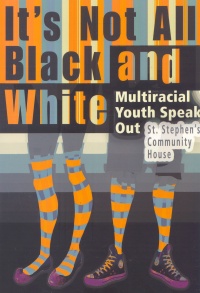| ________________
CM . . .
. Volume XIX Number 8. . . .October 26, 2012
excerpt:
The face of Canada is changing, and especially in large urban areas, that face is no longer white. St. Stephen’s Community House is a social service agency “serving the needs of Kensington Market and surrounding neighborhoods in downtown West Toronto since 1962.” (vi). It’s Not All Black and White: Multiracial Youth Speak Out is the outcome of the agency’s “Making Sense of One” project, co-ordinated by Karen Arthurton, herself a woman of mixed-race background. Nearly twenty mixed-race youth, members of a weekly drop-in discussion group, contributed to this book, and as with two previous St. Stephen’s projects published by Annick Press, (The Little Black Book for Girlz and The Little Black Book for Guys, the stories, observations, and experiences are presented in a variety of forms: poetry, interviews, lyrics, black and white artwork. As well, it’s not just youth who have stories to tell; included are the stories of their parents who provide insights into the challenges they faced, particularly during previous decades when inter-racial relationships far less common. It’s Not All Black and White begins by defining the terms “race”, “mixed race”, and “culture” as used in the context of the book. Chapter 1, “We’ve Come a Long Way”, provides the teens’ perspectives on the first steps in their life journey. As children, there’s awareness that their parents look different from each other, and, as a result, sometimes there is alienation and cut-off from extended family members. Sometimes, they grow up not knowing grandparents, aunts and uncles, cousins, and even when they do, attitudes of those relatives can be less than accepting. Then, as they enter the world of school, there are often early experiences of racism: slurs, insults, condescension. So much of the negative attitudes and behaviours these young people experience are a response to their appearance. A sense of one’s identity as a mixed race individual often comes from the degree to which he or she does or does not “look” white, Native, Asian, black, whatever. Stereotypes about appearance lead to comments such as, “What pretty hair! Such lovely color! All mixed people are so beautiful! You people are so sexy and exotic.” (24) Then, there are behavioural stereotypes as well. In a double-entry dialogue entitled “Black & White”, Andrew asks, “Are you saying that every black person is a good basketball player?” (29) Some decided that it is just easier to “pass” and “play the white card” (49), knowing that it’s false and denying of one’s real self. Chapter 3, “My World Around Me”, explores the complications of connections with family, friends and the greater community. It’s problematic – do mixed race teens become the “token race” friend? How do they deal with racist jokes or comment? How do they create an identity that includes a place in both or all of the cultures to which they belong? High schools can be cliquey at the best of times, and fitting in can be difficult, regardless of one’s race or ethnic background; multi-racial teens find it even more of a challenge. And, then, there is family; some families are supportive and accepting, allowing teens to feel that they belong to their many-cultured backgrounds, while other families actively discourage connection. Although many of the book’s stories are about personal struggles, the book’s final chapter, “Above and Beyond Race”, makes it clear that “as we grow and change, race will become less important as we discover that it is only one aspect of our beautiful selves.” (88) Struggle often leads to strength, and Chapter 4 celebrates the lessons learned, the pride in personal growth, and the understanding which comes with reflection. Just as the book began with Karen Arthurton’s comments, it ends with her “Advice for Parents and Caregivers”. Dealing with teens is never easy, but multi-racial background adds another layer of complexity. Arthurton’s suggestions are practical and raise awareness of issues that a person of another racial background might not consider; above all, communication, even of difficult issues, is paramount. Nothing is gained by pretending that issues don’t exist or by dismissing or denying them. Although some of the contributors to the book chose to remain anonymous, the final pages offer brief notes identifying many of the young contributors, providing readers with their own descriptions of who they are and how they define themselves. It’s Not All Black and White speaks to a variety of potential audiences in the upper senior high school grades. Undoubtedly, its stories will resonate with mixed race teens, but those who aren’t of mixed race will become aware of issues they have neither considered nor experienced. For those who do not live in large urban communities with ethnically and racially diverse populations, there is much to be learned from this book. Parents of mixed race teens, teachers, guidance counselors and those who work in multiracial communities will all find something to assist them to support the mixed race teens in their lives. Highly Recommended. Joanne Peters, a retired high school teacher-librarian, lives in Winnipeg, MB.
To comment
on this title or this review, send mail to cm@umanitoba.ca.
Copyright © the Manitoba Library Association. Reproduction for personal
use is permitted only if this copyright notice is maintained. Any
other reproduction is prohibited without permission.
NEXT REVIEW |
TABLE OF CONTENTS FOR THIS ISSUE
- October 26, 2012.
AUTHORS |
TITLES |
MEDIA REVIEWS |
PROFILES |
BACK ISSUES |
SEARCH |
CMARCHIVE |
HOME |
